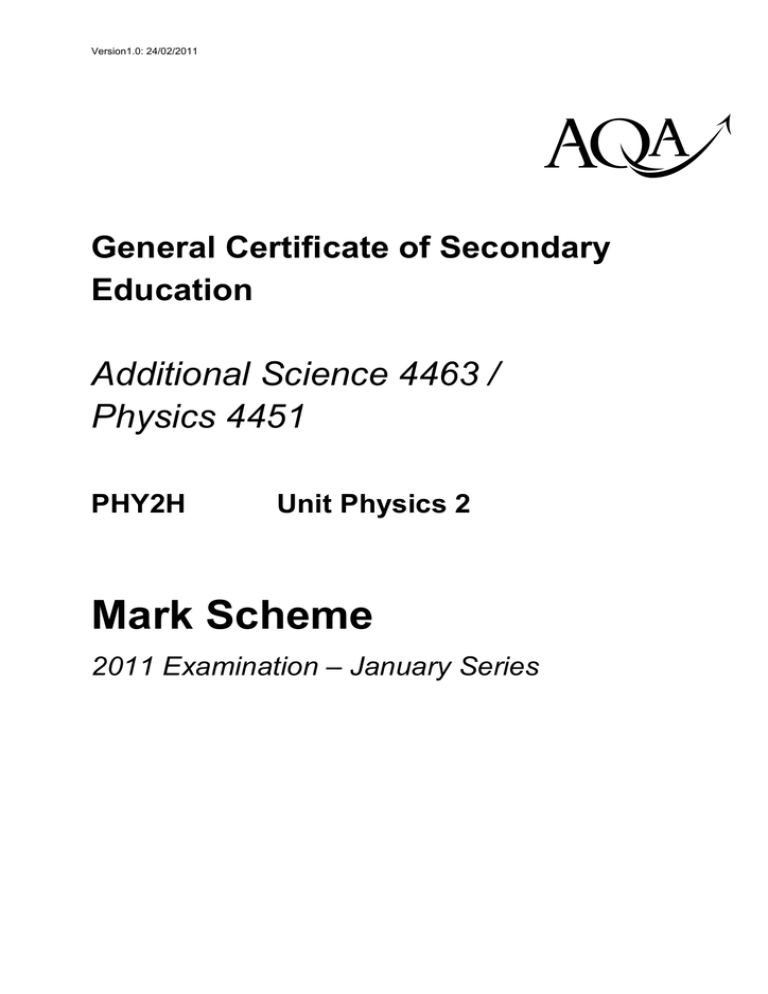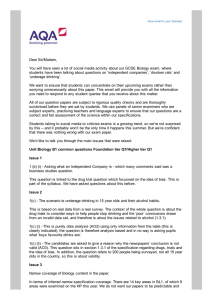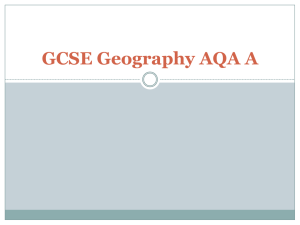
Version1.0: 24/02/2011
klm
General Certificate of Secondary
Education
Additional Science 4463 /
Physics 4451
PHY2H
Unit Physics 2
Mark Scheme
2011 Examination – January Series
Mark schemes are prepared by the Principal Examiner and considered, together with the
relevant questions, by a panel of subject teachers. This mark scheme includes any
amendments made at the standardisation meeting attended by all examiners and is the scheme
which was used by them in this examination. The standardisation meeting ensures that the
mark scheme covers the candidates’ responses to questions and that every examiner
understands and applies it in the same correct way. As preparation for the standardisation
meeting each examiner analyses a number of candidates’ scripts: alternative answers not
already covered by the mark scheme are discussed at the meeting and legislated for. If, after
this meeting, examiners encounter unusual answers which have not been discussed at the
meeting they are required to refer these to the Principal Examiner.
It must be stressed that a mark scheme is a working document, in many cases further
developed and expanded on the basis of candidates’ reactions to a particular paper.
Assumptions about future mark schemes on the basis of one year’s document should be
avoided; whilst the guiding principles of assessment remain constant, details will change,
depending on the content of a particular examination paper.
Further copies of this Mark Scheme are available to download from the AQA Website: www.aqa.org.uk
Copyright © 2011 AQA and its licensors. All rights reserved.
COPYRIGHT
AQA retains the copyright on all its publications. However, registered centres for AQA are permitted to copy material
from this booklet for their own internal use, with the following important exception: AQA cannot give permission to
centres to photocopy any material that is acknowledged to a third party even for internal use within the centre.
Set and published by the Assessment and Qualifications Alliance.
The Assessment and Qualifications Alliance (AQA) is a company limited by guarantee registered in England and Wales (company number 3644723) and a registered charity (registered charity number 1073334).
Registered address: AQA, Devas Street, Manchester M15 6EX
2
Additional Science / Physics – PHY2H – AQA GCSE Mark Scheme 2011 January Series
Marking Guidance for Examiners
GCSE Science Papers
1.
General
The mark scheme for each question shows:
•
the marks available for each part of the question
•
the total marks available for the question
•
the typical answer or answers which are expected
•
extra information to help the Examiner make his or her judgement and help to
delineate what is acceptable or not worthy of credit or, in discursive answers,
to give an overview of the area in which a mark or marks may be awarded.
The extra information is aligned to the appropriate answer in the left-hand part of
the mark scheme and should only be applied to that item in the mark scheme.
At the beginning of a part of a question a reminder may be given, for example:
where consequential marking needs to be considered in a calculation;
or the answer may be on the diagram or at a different place on the script.
In general the right hand side of the mark scheme is there to provide those extra
details which confuse the main part of the mark scheme yet may be helpful in
ensuring that marking is straightforward and consistent.
2.
3.
Emboldening
2.1
In a list of acceptable answers where more than one mark is available ‘any
two from’ is used, with the number of marks emboldened. Each of the
following lines is a potential mark.
2.2
A bold and is used to indicate that both parts of the answer are required to
award the mark.
2.3
Alternative answers acceptable for a mark are indicated by the use of or.
(Different terms in the mark scheme are shown by a / ; eg allow smooth /
free movement.)
Marking points
3.1
Marking of lists
This applies to questions requiring a set number of responses, but for
which candidates have provided extra responses. The general principle to
be followed in such a situation is that ‘right + wrong = wrong’.
Each error/contradiction negates each correct response. So, if the number
of error/contradictions equals or exceeds the number of marks available for
the question, no marks can be awarded.
However, responses considered to be neutral (indicated as * in example 1)
are not penalised.
3
Additional Science / Physics – PHY2H – AQA GCSE Mark Scheme 2011 January Series
Example 1: What is the pH of an acidic solution? (1 mark)
Candidate
Response
Marks
awarded
1
4,8
0
2
green, 5
0
3
red*, 5
1
4
red*, 8
0
Example 2: Name two planets in the solar system. (2 marks)
3.2
Candidate
Response
Marks awarded
1
Pluto, Mars, Moon
1
2
Pluto, Sun, Mars,
Moon
0
Use of chemical symbols / formulae
If a candidate writes a chemical symbol / formula instead of a required
chemical name, full credit can be given if the symbol / formula is correct
and if, in the context of the question, such action is appropriate.
3.3
Marking procedure for calculations
Full marks can be given for a correct numerical answer, as shown in the
column ‘answers’, without any working shown.
However if the answer is incorrect, mark(s) can be gained by correct
substitution / working and this is shown in the ‘extra information’ column;
3.4
Interpretation of ‘it’
Answers using the word ‘it’ should be given credit only if it is clear that the
‘it’ refers to the correct subject.
3.5
Errors carried forward
Any error in the answers to a structured question should be penalised once
only.
Papers should be constructed in such a way that the number of times
errors can be carried forward are kept to a minimum. Allowances for errors
carried forward are most likely to be restricted to calculation questions and
should be shown by the abbreviation e.c.f. in the marking scheme.
3.6
Phonetic spelling
The phonetic spelling of correct scientific terminology should be credited
unless there is a possible confusion with another technical term.
3.7
Brackets
(…..) are used to indicate information which is not essential for the mark to
be awarded but is included to help the examiner identify the sense of the
answer required.
4
Additional Science / Physics – PHY2H – AQA GCSE Mark Scheme 2011 January Series
PHY2H
Question 1
question
answers
extra information
mark
1(a)(i)
120
1
1(a)(ii)
20
1(a)(iii)
as speed increases
1
drag force / water resistance /
friction / D increases
1
accept 140-their (a)(i) provided
answer is not negative
forces balance is insufficient
(until) D = 140 N or (until) D = T
1
1
1(b)(i)
(average) speed (of swimmer)
1
1(b)(ii)
any two from:
2
•
more data
•
force may vary (a lot) /
change
•
give more reliable average
accept results for data
do not accept more accurate data
ignore references to anomalies
ignore accurate / precise
Question 1 continues on the next page . . .
5
Additional Science / Physics – PHY2H – AQA GCSE Mark Scheme 2011 January Series
PHY2H
Question 1 continued . . .
question
1(b)(iii)
1(b)(iv)
answers
extra information
mark
1
examples of acceptable
responses:
•
most / some females produce
smaller forces
do not accept all females produce
smaller forces
•
most / some males produce
larger forces
do not accept all males produce
larger forces
•
some females swim as fast as
males but use a smaller force
•
most of the faster swimmers
are male
do not accept all males swim
faster
•
most of the slower swimmers
are female
do not accept all females swim
slower
•
range of the (average) speed
of males is smaller than the
range of the (average) speed
of females
•
range of the (average) force
of the males is greater than
the range of the (average)
force of the females
exert maximum (hand) force
(throughout the swim / stroke)
accept (any method to) increase
(hand) force
1
practise more is insufficient
Total
10
6
Additional Science / Physics – PHY2H – AQA GCSE Mark Scheme 2011 January Series
PHY2H
Question 2
question
2(a)
answers
extra information
3rd box
mark
1
The negative charge in the water
is repelled by the rod and the
positive charge is attracted.
2(b)(i)
friction between bottles and
conveyor belt / (plastic) guides
accept bottles rub against
conveyor belt / (plastic) guides
1
charge transfers between bottles
and conveyor belt / (plastic)
guides
accept specific reference
eg electrons move onto / off the
bottles
1
reference to positive electrons /
protons negates this mark
2(b)(ii)
an atom that has lost / gained
electron(s)
do not accept a charged particle
1
2(b)(iii)
charge will not (easily) flow off the
conveyor belt
accept the conveyor belt / bottle is
an insulator / not a conductor
1
accept conveyor belt is rubber
Total
5
7
Additional Science / Physics – PHY2H – AQA GCSE Mark Scheme 2011 January Series
PHY2H
Question 3
question
3(a)(i)
3(a)(ii)
answers
extra information
accept correctly named example
any one from:
•
food / drink
•
rocks / building materials
•
cosmic rays / rays from
space
mark
1
1
any one from:
•
nuclear power / coal power
(stations)
accept nuclear waste
•
nuclear accidents
accept named accident eg
Chernobyl
•
nuclear weapons testing
accept named medical procedure
which involves a radioactive
source
accept radiotherapy
nuclear activity / radiation is
insufficient
do not accept CT scans
3(a)(iii)
accept does not have 86 protons
accept only has 84 protons
different number of / fewer
protons
1
or
do not accept bottom number
different
different atomic number
reference to mass number
negates this mark
Question 3 continues on the next page . . .
8
Additional Science / Physics – PHY2H – AQA GCSE Mark Scheme 2011 January Series
PHY2H
Question 3 continued . . .
question
3(b)
answers
extra information
168
accept 169 if clear, correct
method is shown
mark
2
allow 1 mark for a correct dose
ratio involving the spine
eg 2:140 etc
or ratio of days to dose is 1.2
or ratio of dose to days is 0.83
3(c)(i)
Group A
JMO
3(c)(ii)
all correct
Group
B
KLN
1
any order within each group
similar (number) / same (number)
/ large (number)
accept the same specific number
in each group eg three
1
reference to other factors such as
age is neutral
3(c)(iii)
how many people in each group
developed cancer
a clear comparison is required
1
Question 3 continues on the next page . . .
9
Additional Science / Physics – PHY2H – AQA GCSE Mark Scheme 2011 January Series
PHY2H
Question 3 continued . . .
question
answers
3(c)(iv)
extra information
mark
there are no marks for Yes or No
the mark is for the reason
1
Yes
the benefit of having the scan is
greater than the risk
or
the risk is (very) small (compared
to the chance from natural
causes)
accept the risk is much greater
from natural causes
No
no additional risk is acceptable
Total
9
10
Additional Science / Physics – PHY2H – AQA GCSE Mark Scheme 2011 January Series
PHY2H
Question 4
question
answers
4(a)
1 080 000
4(b)
any one from:
•
KE (of wind) more than
doubles
•
mass of air (hitting blades)
more than doubles
•
area swept out by blades
more than doubles
•
area swept out by blades
increases × 4
extra information
allow 1 mark for correct
substitution
ie ½ × 15 000 × 12 × 12
mark
2
1
do not accept blades are larger /
have a bigger area
Total
3
11
Additional Science / Physics – PHY2H – AQA GCSE Mark Scheme 2011 January Series
PHY2H
Question 5
question
answers
extra information
mark
5(a)
diode
accept LED
1
5(b)
all symbols correct
must include at least voltmeter
and diode
1
allow ecf from part (a) if the
component is not identified as a
diode
allow symbol without the line
through triangle
ignore polarity of diode
voltmeter in parallel with
component added in series
1
any additional components must
not affect the ability to measure V
and I for the diode / their (a)
5(c)(i)
0.05
1
accept 50 mA
accept between 0.048 and 0.050
inclusive
5(c)(ii)
2
16
0.8
their (c)(i) correctly calculated
gains both marks
allow 1 mark for correct
transformation and substitution
ie
0.8
0.05
or
0.8
their (c)(i)
allow 17 if using 0.048
Total
6
12
Additional Science / Physics – PHY2H – AQA GCSE Mark Scheme 2011 January Series
PHY2H
Question 6
question
answers
6(a)(i)
0.25 (A)
6(a)(ii)
75
extra information
mark
1
2
allow 1 mark for converting 5
minutes to 300 seconds
or allow 1 mark for correct
substitution
ie 0.25 × 300
allow 1 mark for an answer 1.25
allow 1 mark only for their
(a)(i) × 300 correctly calculated
do not accept c
coulombs or C
6(b)
1
2
any two from:
accept if a fault was to occur
•
fault not repaired
•
larger current will (still) flow
•
aluminium foil will not melt
(if a fault)
accept aluminium foil needs a
higher current / charge to melt
•
wiring will overheat / (may)
cause a fire
accept idea of fire hazard
do not accept explode etc
Total
6
13
Additional Science / Physics – PHY2H – AQA GCSE Mark Scheme 2011 January Series
PHY2H
Question 7
question
answers
7(a)
direction
7(b)
54 000
extra information
mark
1
2
allow 1 mark for calculating and
identifying momentum as 10 800
or
allow 1 mark for correct
substitution into second equation
ie 1200 × 9
0.2
7(c)
accept increases impact time
increases the time taken (for
head) to stop
1
do not accept reference to
slowing down time unless qualified
accept reduces acceleration /
deceleration
decreases rate of change in
momentum
1
accept increases the time taken
to reduce momentum to zero is
worth 2 marks
reduces momentum is insufficient
1
reduces the force (on the head)
Total
6
14





